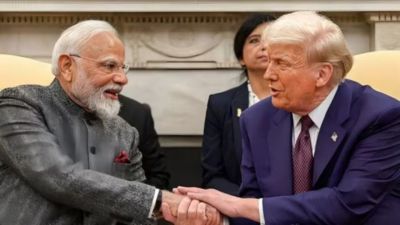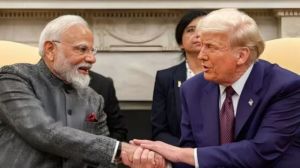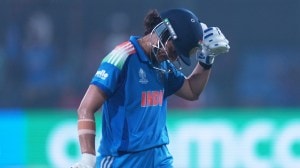Are we like this only?
Guha presents a grand panorama of the unfolding of sixty years of India’s political history. It is worthy of a diamond jubilee

India after gandhi: The
History of the World’s
Largest Democracy
Ramachandra Guha
Picador, Rs 695
Like 1757 and 1857,” Ramachandra Guha writes in a forgivable over-statement, “1957 was also a year of momentous importance in the history of modern India.” That year the Indian republic held its second general elections, proving that the 1952 experiment had not been a flash in the pan. The regularity of a reference to the people on which political formation should rule India was now firmly established. The communist victory in the state of Kerala signaled the first successful regional electoral challenge to the Congress party’s dominance at the centre. The storm in Parliament over the LIC’s investments in the firm of Haridas Mundhra gave the country its first full-blown financial scandal and an early indication of political corruption seeping steadily into the body politic.
Choosing “the more primitive techniques of the narrative historian” over “the methods of statistical social science”, Guha gives us a lucid and lively chronicle of independent India’s adventurous engagement with democracy. His choice of techniques is fully vindicated in a book that is from beginning to end a genuine pleasure to read. With an eye for detail and a knack for finding the most telling anecdotes, Guha presents a grand panorama of the unfolding of sixty years of India’s political history. It is a book worthy of a diamond jubilee.
In giving an overall assessment of the track record of India’s democracy, Guha borrows a line from the Hindi comic actor Johnny Walker: “Boss, phipty-phipty.” The “hardware” of democracy in the form of elections and a free media looks to be in pretty good shape. Its “software”, by contrast, has been infected and corrupted by viruses of the dynastic and criminal assortments. Presented with a spectacle of a glass half-empty and half-full, Guha is nevertheless prepared to raise a toast to India’s half-impressive achievement.
The fifty per cent rate of success seems especially remarkable in the context of predictions by a motley array of Western doomsayers whom Guha sets up as straw men to be systematically demolished. The book opens with an unwarranted pessimistic premise about the prospects of Indian democracy and unity after 1947. Had the author turned in a serious fashion to consider India’s pre-colonial and anti-colonial political thought and practice, such lowly expectations would have been dispelled. India has a long and rich history of the ethics of good governance and the ideal of uniting without destroying the autonomy of its many peoples. The fifty per cent rate of failure had much to do with independent India turning its back on that history in an ill-judged decision to rely on the instruments of an over-centralised state inherited from the colonial masters.
Both individuals and institutions are prominent actors in Guha’s dramatic story. India’s first prime minister was a majestic man prone to committing Himalayan blunders. Carried away by his sta-rry-eyed admiration for Jawaharlal Nehru, the author seeks to throw a cloak of Teflon over the shoulders of his hero. Yet the Nehru jacket does not remain wholly unstained. Even if we leave out of account his foibles before independence, the architect of India’s parliamentary democracy equated communists and federalists with terrorists in the late 1940s, let the Gandhian Potti Sriramalu die of starvation in 1952, threw his friend Sheikh Abdullah into prison in 1953, turned a blind eye to human rights violations in Nagaland in 1956, acquiesced in the dismissal of a duly elected state government in 1959 and led India into a military debacle against China in 1962. Why should we consider his decision to release Abdullah in 1964 to be more significant than his resolve to incarcerate him for more than a decade? The only justification for doing so would be to persuade the custodians of Nehru’s papers to let scholars and the public know the terms on which the ailing prime minister was prepared to solve the Kashmir riddle.
In answering the question why India has survived as a democracy and a unified entity, Guha gives much credit to a colonial institution — the much vaunted Indian civil service. It is well-known that after independence Nehru and Patel both embraced the bureaucracy they had castigated as being antithetical to democracy in the days of the anti-colonial struggle. Patel made somewhat better use of the steel frame of the Raj in integrating the princely states with the Indian union. The civil service doubtless contained some very able individuals. Sukumar Sen, the chief election commissioner during the first two general elections, was, as Guha points out, an ICS man. Yet, Guha refuses to recognise the extent to which the Congress party’s marriage of convenience with the bureaucracy transformed Nehruvian socialism into a stifling form of statism. India’s political economy has been breaking free of those shackles only since 1991.
Guha is as critical of Indira Gandhi as he is enamoured of her father. Nehru’s “halting yet honest attempts to promote a democratic ethos” were, in his view, “undone by his own daughter, and in decisive and dramatic ways”. The authoritarian streak in Indira Gandhi, clearly on display during the years of the emergency, is well-known. But in the 1969-1973 period she had widened and deepened the democratic social base of the Congress party and in so doing had revived its electoral fortunes. The broad social coalition she conjured up in UP, for example, has been only partially replicated recently by Mayawati, albeit under Dalit rather than Brahmin leadership. It is a trifle unfair to see Indira Gandhi’s advisor P.N. Haksar’s leftism as purely ideological and hers as crassly pragmatic, if not cynical.
In Guha’s temporal scheme, India in the first two post-independence decades was a constitutional democracy, while in the last two decades it has become a populist one. The middle two decades, therefore, constitute the era of this transition. The book is much more engaging on the first rather than the second thirty-year time span. One reason for this is that it moves, by Guha’s own admission, from history to “historically informed journalism”. But there is also a second reason. As a self-professed liberal, Guha invests greater emotional and intellectual effort in his imagined golden age of constitutional democracy. He is not entirely oblivious of the oligarchical nature of Nehruvian democracy relying on provincial party bosses to bring in the vote. He recognises India’s gravest political failures to have been in the domains of education and health. He quotes B.V. Krishnamurti, a lecturer in Bombay, who noted the allocation for primary education in the second plan was “absurdly low” in light of the constitutional obligation to provide free and compulsory education to all children up to the age of fourteen. But Guha is unable to squarely face the fact that the roots of India’s biggest failures lay in the pathetic lack of public action in the heyday of constitutional democracy.
Guha’s nostalgia, however, is not entirely misplaced. He is right in noting “a rapid, even alarming decline in the quality of the men and women who rule India”. There is one major difference between 1947 and 2007. On 15 August, 2007, members of India’s political class will all be in celebratory mode. Sixty years ago Mahatma Gandhi had stayed away from the celebrations in New Delhi to quietly mourn the human tragedy of partition in a Muslim neighbourhood of Calcutta. India after Gandhi has sorely missed the presence of a great soul prepared to abjure the lights of the capital to light up the darkness engulfing the lives of those who are poor and obscure.
Sugata Bose is Gardiner Professor of History, Harvard University, Cambridge, US.





- 01
- 02
- 03
- 04
- 05


























